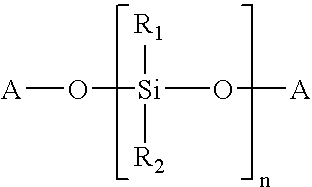Composition curable by metathesis reaction
a technology of metathesis and reaction, applied in the field of compositions, can solve the problems of relatively high dielectric constant and shortcomings of the hydrosilation mechanism in the rtv and lsr types of formulations
- Summary
- Abstract
- Description
- Claims
- Application Information
AI Technical Summary
Benefits of technology
Problems solved by technology
Method used
Image
Examples
example 1
A telechelic poly(dimethylsiloxane) end-capped with norbornenylethyl groups (Compound 1) was synthesized according to the following scheme using KOH as the acid scavenger:
A 2L reaction kettle equipped with a mechanical stirrer, N2 inlet-outlet and a thermal couple was charged with 900 g (0.06 mol, Polymer OH 0.75, Hans Chemie) silanol terminated poly(dimethylsiloxane) (PDMS). The system was cooled to 4° C. with an ice-water bath. Then, 25.78 g (0.12 mol) 2-(5-norbornenyl)ethyldimethylchlorosilane was added dropwise with a dropping funnel followed by 7.7 g (0.12 mol, 40 mesh, Aldrich Chemical, semiconductor grade, 87% purity) ground KOH and the reaction continued under stirring at ice-water temperature for three hours. The system was subjected to vacuum (about 2 torr) while the temperature was gradually raised to 80° C. over 30 minutes. The reaction continued at 80° C. for one hour under vacuum. A resin, Compound 1, was obtained with a viscosity of 1.4 Pa.s. The resin was allowed to...
example 2
A poly(dimethylsiloxane) tethered and end-capped with norbornenylethyl groups (Compound 2) was synthesized according to the following scheme using KOH as acid scavenger:
A 2L reaction kettle equipped with a mechanical stirrer, N2 inlet-outlet and a thermal couple was charged with 900 g (0.06 mol, Polymer OH 0.75, Hans Chemie) silanol terminated poly(dimethylsiloxane) (PDMS). The system was cooled to 4° C. with an ice-water bath. Then, a mixture of 8.55 g (36.3 mmol) 2-(5-norbornenyl) ethylmethyldichlorosilane and 10.55 g (47.3 mmol) 2-(5-norbornenyl) ethyldimethylchlorosilane was added dropwise with a dropping funnel followed by 8.51 g (132 mmol, 40 mesh, Aldrich Chemical, semiconductor grade, 87% purity) ground KOH and the reaction continued under stirring at ice-water temperature for three hours. The system was subjected to vacuum (about 2 torr) while the temperature was gradually raised to 80° C. over 30 minutes. The reaction continued at 80° C. for one hour under vacuum. A resin...
example 3
A quadri-functional poly(dimethylsiloxane), referred to as a Q-resin, end-capped with norbornenylethyl groups (Compound 3) was synthesized according to the following scheme.
A 1L round bottom flask equipped with a Dean-Stark trap and a magnetic spin bar was charged with 50 g silanol terminated Q-resin (SQO—299, Mw 3000-4000, OH 1.7-2.0% from Gelest Corp.) dissolved in 250 mL toluene. The system was cooled to 0° C. with an ice-water bath. Then, 15.8 g (74 mmol) 2-(5-norbornenyl)ethyldimethylchlorosilane and 5.22 g (81 mmol, 40 mesh, Aldrich Chemical, semiconductor grade, 87% purity) ground KOH were added. The reaction continued under stirring at 0° C. for three hours. The reaction was stirred overnight at room temperature, then under reflux the water-azeotrope was removed. After cooling down, salts were removed by vacuum filtration and toluene was evaporated on a rotary evaporator to afford a semi-solid product, Compound 3. The yield was 97%. The results of NMR (Nuclear Magnetic Reson...
PUM
| Property | Measurement | Unit |
|---|---|---|
| Fraction | aaaaa | aaaaa |
| Fraction | aaaaa | aaaaa |
| Fraction | aaaaa | aaaaa |
Abstract
Description
Claims
Application Information
 Login to View More
Login to View More - R&D
- Intellectual Property
- Life Sciences
- Materials
- Tech Scout
- Unparalleled Data Quality
- Higher Quality Content
- 60% Fewer Hallucinations
Browse by: Latest US Patents, China's latest patents, Technical Efficacy Thesaurus, Application Domain, Technology Topic, Popular Technical Reports.
© 2025 PatSnap. All rights reserved.Legal|Privacy policy|Modern Slavery Act Transparency Statement|Sitemap|About US| Contact US: help@patsnap.com



